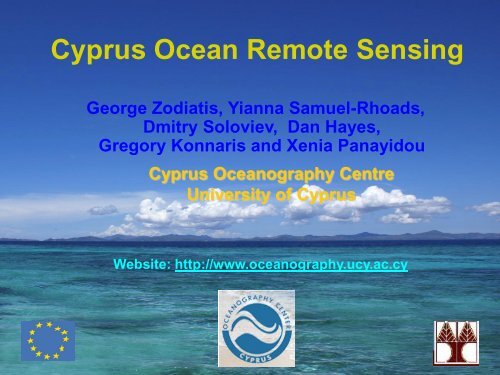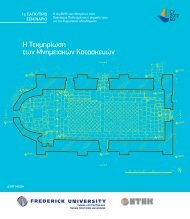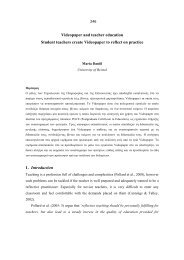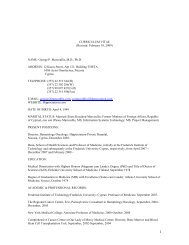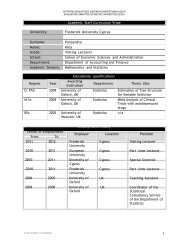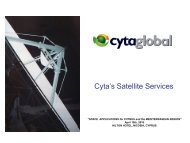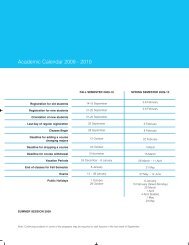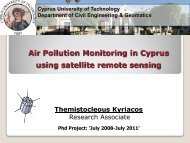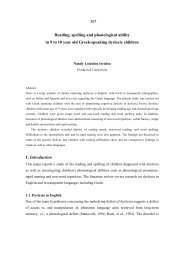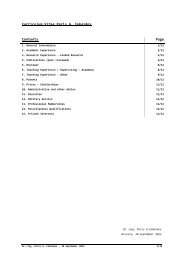Cyprus Ocean Remote Sensing - Frederick University
Cyprus Ocean Remote Sensing - Frederick University
Cyprus Ocean Remote Sensing - Frederick University
You also want an ePaper? Increase the reach of your titles
YUMPU automatically turns print PDFs into web optimized ePapers that Google loves.
<strong>Cyprus</strong> <strong>Ocean</strong> <strong>Remote</strong> <strong>Sensing</strong><br />
George Zodiatis, Yianna Samuel-Rhoads,<br />
Dmitry Soloviev, Dan Hayes,<br />
Gregory Konnaris and Xenia Panayidou<br />
<strong>Cyprus</strong> <strong>Ocean</strong>ography Centre<br />
<strong>University</strong> of <strong>Cyprus</strong><br />
Website: http://www.oceanography.ucy.ac.cy
Outline<br />
OC-UCY<br />
CYCOFOS description<br />
CYCOFOS ocean remote sensing<br />
Sea Surface Temperature<br />
Chlorophyll-a<br />
Zooplankton Egg Rate<br />
Oil Spill Detection and Modelling<br />
Conclusion
Introduction<br />
In 2003, the <strong>Cyprus</strong> <strong>Ocean</strong>ography Centre<br />
was established after the merge of the<br />
<strong>Ocean</strong>ography Laboratory operated within<br />
the Department of Fisheries and of the<br />
newly Computational <strong>Ocean</strong>ography Group<br />
activated at the <strong>University</strong> of <strong>Cyprus</strong>.<br />
In 2008, the <strong>Cyprus</strong> <strong>Ocean</strong>ography Centre<br />
became part of the School of Physical<br />
Applied Science of the <strong>University</strong> of <strong>Cyprus</strong><br />
following a decision of the <strong>Cyprus</strong> Ministerial<br />
Board for the consolidation of the Center.
Mission<br />
Mission of <strong>Cyprus</strong> <strong>Ocean</strong>ographic Center is to:<br />
contribute through research in the increase of the<br />
scientific knowledge in the Eastern Mediterranean,<br />
improve and develop various components of<br />
operational oceanography in the region,<br />
operate the <strong>Cyprus</strong> Coastal <strong>Ocean</strong> Forecasting and<br />
Observing System (CYCOFOS), in cooperation with<br />
operational ocean forecasting networks in Europe,<br />
the Mediterranean (MOON), within the scopes of<br />
EuroGOOS, MedGOOS and GMES,<br />
demonstrate, assist and provide information on the<br />
marine environment to the decision makers and to the<br />
public,<br />
offer consultant services to other government (such<br />
as search and rescue operations, oil spill pollution,<br />
pelagic fisheries, etc) and private sectors.
Research Directions<br />
At present the main research directions of the<br />
<strong>Cyprus</strong> <strong>Ocean</strong>ography Centre are:<br />
Numerical modeling : circulation, sea state, dispersion<br />
<strong>Remote</strong> sensing : in-situ and satellite<br />
Monitoring : coastal and offshore oceanographic cruises<br />
Operational <strong>Ocean</strong>ography: Improvement and development<br />
of monitoring and forecasting systems of CYCOFOS<br />
Climatic Changes: T, S rise in the Levantine Basin<br />
Data management and information: Dedicated<br />
oceanographic data and marine metadata bases.<br />
Biological <strong>Ocean</strong>ography: estimate zooplankton<br />
productivity using satellite SST and CHL, collect<br />
zooplankton samples from <strong>Cyprus</strong> and using zooscan<br />
instrument identify and count the organisms.
An operational coastal ocean<br />
forecasting and observing<br />
system has been developed in<br />
<strong>Cyprus</strong> and has been<br />
operational since early 2002.<br />
The system is called CYCOFOS<br />
and is a component of the<br />
EuroGOOS and part of MOON.
CYCOFOS satellite remote sensing<br />
CYCOFOS HRPT ground receiving station has been providing regular (daily) NOAA-AVHRR<br />
SST images of the Levantine Basin and of the Eastern Mediterranean Sea.<br />
CYCOFOS satellite remote sensing module at the OC-UCY process regularly (daily) satellite<br />
data for:<br />
• Sea Surface Temperature<br />
• Chlorophyll-a<br />
• Light Attenuation<br />
• Sea surface zooplakton<br />
• Sea surface temperature fronts<br />
• Detection for oil slicks<br />
For oil spill detection<br />
• MODIS images are obtained through NASA LAADS (Level 1 Atmosphere Archive &<br />
Distribution System)<br />
• SAR (ENVISAT & RADARSAT1) images through EMSA CleanSeaNet
CYCOFOS <strong>Ocean</strong> <strong>Remote</strong> sensing<br />
Example of SST image from the CYCOFOS HRPT ground receiving station.
CYCOFOS <strong>Ocean</strong> <strong>Remote</strong> sensing<br />
Example of SST image from the CYCOFOS using MODIS Aqua data
31<br />
29<br />
27<br />
25<br />
23<br />
21<br />
19<br />
17<br />
15<br />
SST (°C)<br />
37° N<br />
30° N<br />
37° N<br />
30° N<br />
37° N<br />
30° N<br />
28°<br />
E<br />
1996 1997 1998<br />
2000 2001 2002<br />
2004 2005 2006<br />
37° E 28° E 37° E 28° E 37° E<br />
28° E 37° E<br />
Annual sea surface temperature (SST) anomalies across the<br />
Levantine Basin from 1996-2006.<br />
6/5/1996<br />
12/5/1996<br />
Example of AVHRR SST images for studying climate change<br />
21/10/1996<br />
30/10/1996<br />
6/5/1997<br />
12/5/1997<br />
28/10/1997<br />
4/11/1997<br />
24/07/1998<br />
2/8/1998<br />
12/1/1999<br />
19/01/1999<br />
14/04/1999<br />
21/04/1999<br />
11/5/2000<br />
SST PSAL<br />
Average SST and PSAL from the first 10m<br />
depth during CYBO cruises, 1996 to 1999.<br />
1/9/2000<br />
11/5/2001<br />
29/8/2001<br />
31/5/2002<br />
31/8/2002<br />
24/5/2003<br />
25/8/2003<br />
10/5/2004<br />
25/8/2004<br />
13/9/2005<br />
17/5/2006<br />
39.6<br />
39.4<br />
39.2<br />
39.0<br />
38.8<br />
38.6<br />
+2__<br />
+1__<br />
1999<br />
0__<br />
-1__<br />
2003<br />
-2__<br />
Summer T/S diagram<br />
2003-2006<br />
PSAL (P.S.U)<br />
SST Anomaly (°C)
Example of AVHRR SST images for studying climate change
CYCOFOS flow model:<br />
Validation & Inter-comparison<br />
Models – remote sensing SST,<br />
for September 2004, active mode<br />
Models-ADCP currents<br />
Online Validation Model-Satellite
Statistical Observation of CYCOFOS<br />
SST images<br />
Total received and processed Images: 1945<br />
Total Images Uploaded on the CYCOFOS Web : 1714
CYCOFOS <strong>Ocean</strong> <strong>Remote</strong> sensing<br />
Example of Zooplankton from<br />
MODIS Aqua data<br />
Example of Chlorophyll-a from<br />
MODIS Aqua data
Example of calculating zooplankton egg production rate from<br />
SST and Chlorophyll-a<br />
Zooplankton egg<br />
production rates are<br />
calculated using NOAA-<br />
AVHRR SST data and<br />
MODIS Chlorophyll-a data.
CYCOFOS <strong>Ocean</strong> <strong>Remote</strong> <strong>Sensing</strong><br />
Example of detection of oil slicks using MODIS and SAR images<br />
SAR image<br />
23/06/2007 11:10 UTC<br />
MODIS Image<br />
23/06/2007 07:57 UTC
EMSA and the Levantine Decision Support System<br />
(LEV DESS), a GMES Marine Security Service<br />
CYCOFOS CYCOFOS waves SKIRON<br />
On-line dedicated<br />
database for LEV DESS<br />
Request from<br />
response agencies<br />
(CyDMC, REMPEC,<br />
others)<br />
Outputs<br />
<strong>Ocean</strong> forcing data<br />
MEDSLIK<br />
Online Outputs<br />
EMSA warning reports<br />
to MS agencies<br />
EMSA CleanSeaNet<br />
images<br />
EMSA CleanSeaNet 2<br />
images
Pre-pilot phase: Oil spill predictions following<br />
EMSA warning reports<br />
On the 18th of April 2008, the OC-UCY<br />
has received an emergency request<br />
from the <strong>Cyprus</strong> Department of<br />
Merchant Shipping (CyDMS), after a<br />
warning report from EMSA. EMSA<br />
reported several possible illegal oil<br />
discharges SW of <strong>Cyprus</strong>.<br />
EMSA warring report to the CyDMS,<br />
showing possible oil slicks, as<br />
detected from CSN image on 18/4/08.<br />
EMSA CSN SAR image (added values from<br />
OC-UCY) on the 18 April 2008 showing<br />
possible oil slicks in the Levantine Basin.<br />
Superimposed several oil slicks drift<br />
predictions for 72 h, from 18 – 21/4/08.
Pilot phase: Oil drift predictions following<br />
EMSA CSN images<br />
24h forward and backtracking predictions<br />
in MEDSLIK, following EMSA CSN oil<br />
slicks detection on 11 September 2009.<br />
White: initial oil slick position :0h<br />
(date/time of observation)<br />
Dark green: forecast +24h<br />
Black: backtracking -24h
Real Examples of Oil Spill detection in the<br />
Mediterranean Sea using MODIS images<br />
Lebanese Spill of July 2006<br />
On the 13 and 15 July 2006, the oil tanks at<br />
Jieh power station, located 30 km south of<br />
Beirut and directly on the coast, were hit by<br />
bombs. About 10,000 - 20,000 tons of oil was<br />
spilt into the sea.
MODIS images taken on the<br />
28 July and 3 August, i.e. 15<br />
and 21 days after the start of<br />
the oil pollution incident at the<br />
Jieh thermal power plant
MEDSLIK predicted amounts of<br />
oil permanently stuck on the coast<br />
after 30 days.<br />
Heaviest deposits are near Jieh<br />
and South Beirut. Lighter deposits<br />
as far north as Latakia.
CYCOFOS <strong>Ocean</strong> <strong>Remote</strong> sensing<br />
Example of CYCOFOS Light Attenuation<br />
images from MODIS Aqua data<br />
15-31 May 2002<br />
Example of Tidal<br />
Forecasting using as<br />
initial conditions<br />
satellites altimetry data
MEDSLIK<br />
Conclusion<br />
The CYCOFOS system provides several operational modules and satellite images<br />
on a daily basis, at near-real-time, to local and sub-regional end users in the<br />
Eastern Mediterranean Levantine Basin. The satellite images are used for<br />
improvement through assimilation and validation of the operational ocean flow<br />
forecasts and in oil spill predictions, providing valuable information to the region<br />
supporting the operational response agencies at local, regional and European<br />
level.<br />
The Lebanon oil pollution crisis in summer 2006 demonstrates in best practice the<br />
benefit of having an operational forecasting and observing system in place.<br />
The automatic integration of CYCOFOS MEDSLIK oil spill model with EMSA CSN<br />
satellite data, assisting the implementation of the EU Directive 2005/35.<br />
MODIS<br />
SAR<br />
UN map
Thank you for your attention


